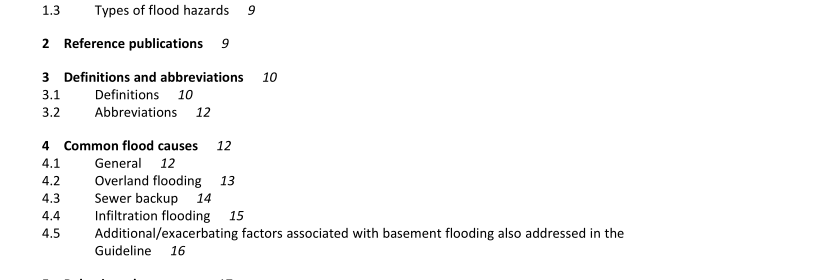CSA Z800-18 pdf download – Guideline on basement flood protection and risk reduction.
3 Definitions and abbreviations 3.1 Definitions The following definitions apply in this Guideline: Backflow — a flowing back or reversal of the normal direction of flow. Backflow preventer — a device that prevents backflow. Backwater event — a condition where backwater valves, when present, are closed as a result of sewer surcharging. Backwater valve — a check valve that is located in a home’s sanitary and/or storm sewer lateral, or branch lines in a home’s basement. Valves close during backwater events, reducing the risk that sewage will return up branches and/or laterals and into homes. Basement flood protection — measures designed to reduce the risk of floodwaters entering homes. Basement flood resilience — a strategy to reduce negative impacts (including physical flood damage to building components), recovery time, and cost of damage following the occurrence of a basement flood event. This strategy relies on the application of flood-damage-resistant materials and construction techniques in basements. Catch basin — basins that channel stormwater (rainwater and snowmelt) to underground stormwater systems.
Coal-tar-impregnated wood fibre pipe — sometimes referred to as “black pipe”, a legacy product used for sanitary laterals in some Canadian communities. Combined sewers — sewers that convey both stormwater and sanitary sewage. Cross-connection — any actual or potential connection between a potable water system and any source of pollution or contamination. Note: Bypass arrangements, jumper connections, removable sections, swivel or changeover devices, or any other temporary or permanent connecting arrangements through which backflow can occur are considered cross- connections. Flood damage-resistant material — construction material capable of withstanding contact with floodwaters without sustaining any damage that requires more than cosmetic repair. Flood elevation — elevation of surface water resulting from a flood event that can be designated by the authority having jurisdiction (e.g., surface water resulting from a riverine flood that has a 1% chance of equalling or exceeding that elevation in any given year) or be selected based on main floor elevation or previous flooding experience. FOG — non-soluble organic fat, oil, and grease from animal or vegetable sources. Foundation drain collector (FDC) — service that is designed to collect foundation drainage discharge only. Grey water — non-biowaste sewage (e.g., from sinks, showers, and laundry tubs), typically collected in a single dwelling unit for reuse within the home. Hydrodynamic load — a load imposed on a building, caused by water flowing against and around it. Source: ASCE/SEI 24-14, with permission from ASCE. Hydrostatic load — a load imposed on a building by a static mass of water. Source: ASCE/SEI 24-14, with permission from ASCE.
Lot grading — the manner in which a lot’s surface is sloped or graded, such that the lot sheds water away from buildings and toward an appropriate stormwater management infrastructure. Municipal drinking water system — the drinking water system, or part of a drinking water system, owned, operated, or maintained by the AHJ. Plumbing system — “a drainage system, a venting system and a water system or parts thereof”. Source: National Plumbing Code, 2015. Resilience — the ability of a structure (or component of it) to withstand events (e.g., earthquake, traffic overload, fatigue, deterioration, flooding) without being damaged to an extent that is disproportionate to the intensity of the events, and its ability minimize recovery time and loss of functionality. Sanitary lateral — an underground sewer pipe that connects a private sanitary drainage system to a sanitary sewer main. This type of service is designed to collect sanitary sewage; however, in older systems it sometimes also conveys stormwater. Sanitary sewers — sewers that collect sewage from homes and businesses and direct it to a central location for treatment and discharge to the environment.CSA Z800-18 pdf download.
